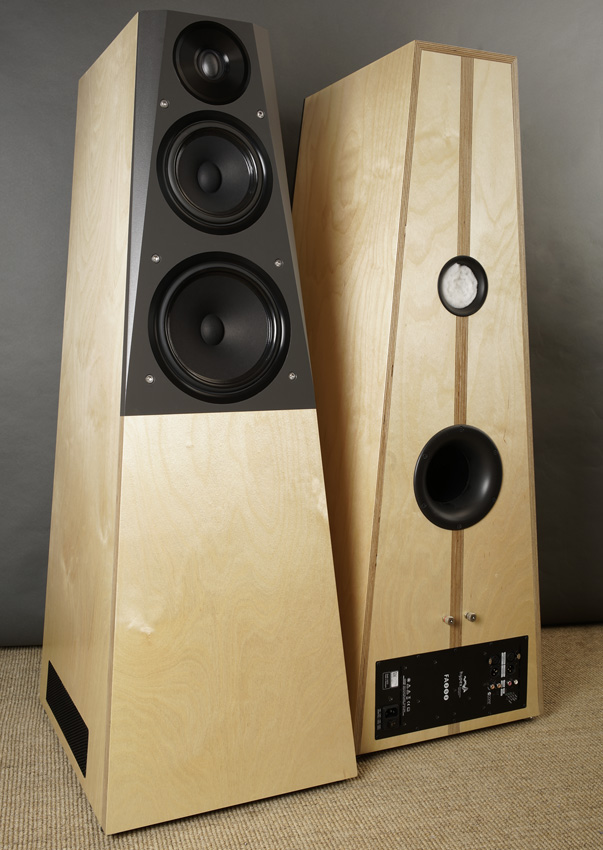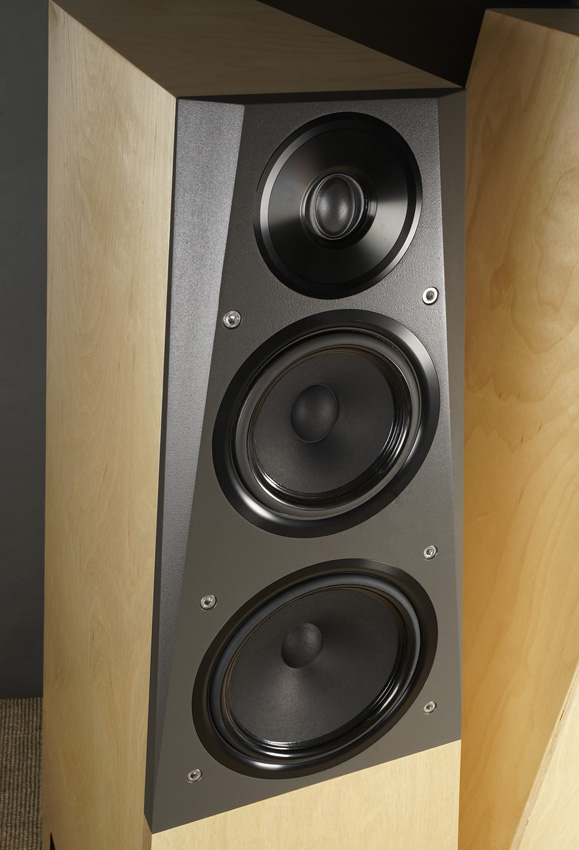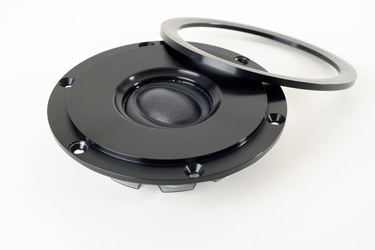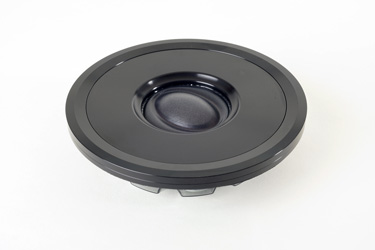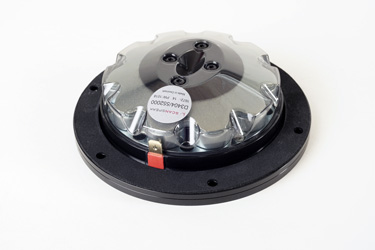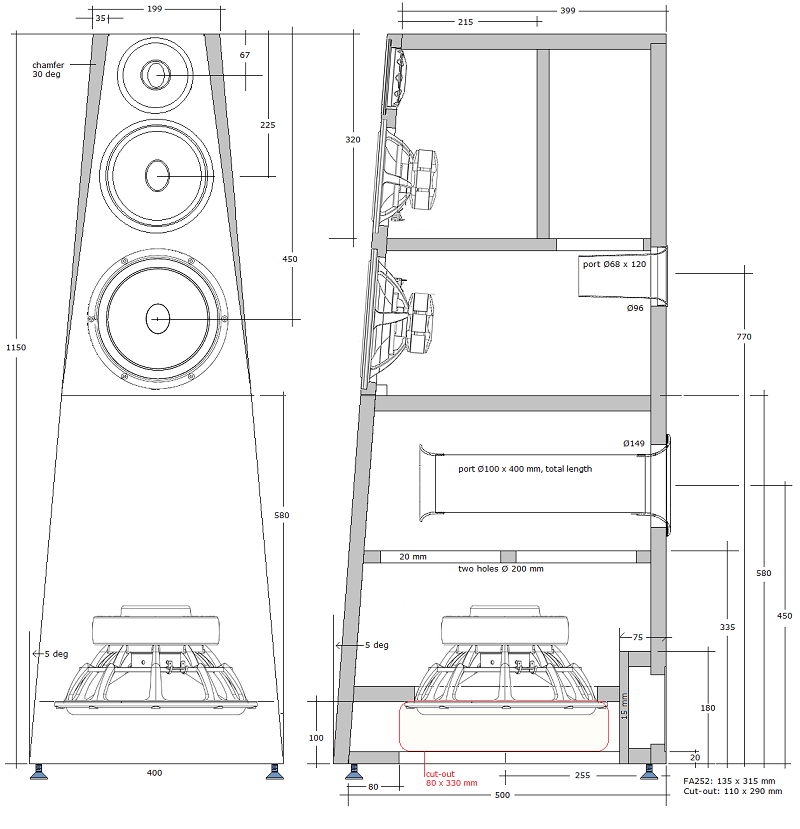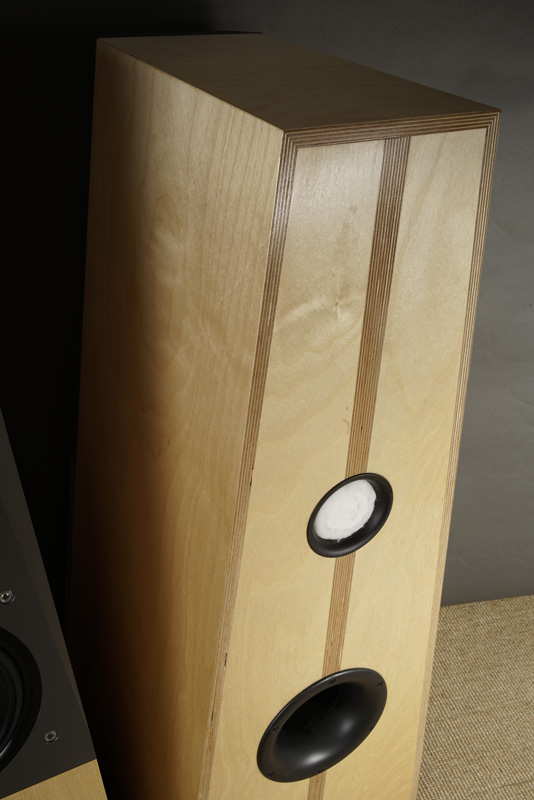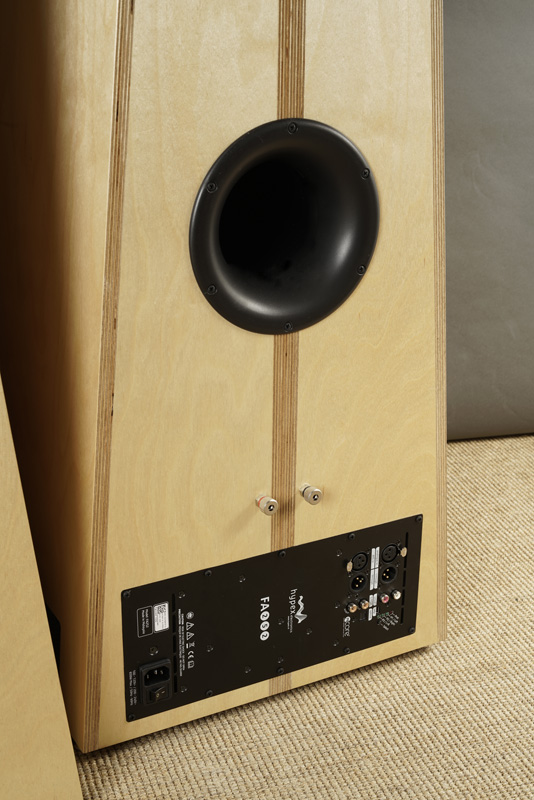DIY Loudspeakers: HOME INDEX UPDATES RESPONSE WHAT'S NEW
Ellipticor-3
Copyright 2022 © Troels Gravesen
Go to on this page:
DRIVERS
CROSSOVER
CABINET
MEASUREMENTS
SPEAKER-KIT
CROSSOVER LAYOUT
SOUND
HYPEX
This is my 6th construction featuring Ellipticor drivers (not all
published) and
I shan't praise the Ellipticor drivers this time. Please read files on
Ellipticor-1 and
Ellipticor-4 if you want to know why I'm so enthusiastic about
these drivers.
With the introduction of the 8" version of Ellipticor, new opportunities
were emerging for creating larger speaker systems with significant power
handling and still - overall simplicity. Even more simple than I had
imagined. These drivers have made me do
stuff I've never done before - at least not with good results.
The special thing about this Ellipticor-3 is that we do not
have a high-pass filter
for the two midrange drivers as is standard for larger speaker
systems and the two drivers are working in a 2½-way fashion, where the
21WE adds to the low-end of the 18WE. And due to inherent smooth
response, we only have a single coil to each of the two drivers,
creating target roll-off. I've never before had drivers that could do
this. We are dealing with 1st order filters.
The Ellipticor-3 has been a playground for numerous crossovers and
initially I meant to publish two, but one of them continuously
proved the other inferior, so only one will be presented - and it's
a rather unusual one. I had a good friend doing a blind test, where I
played two pieces of classical music on two different crossovers
creating the same frequency response within ½ dB. He didn't know what he
was listening to and he immediately picked the simplest crossover, which
was my own favourite too - which he obviously didn't know in advance. "This just
sounds more natural!".
I guess it was Sonus Faber that many years ago launched a smaller
two-way without any tweeter series capacitors: "Sine Cap". This takes a
high efficiency tweeter as the attenuation resistor combined with a
parallel coil goes directly to ground. With the D3404 it can be done
without hitting rock bottom on the impedance curve.
The basic crossovers topology was - as always - done by simulation, but the
final tuning was done by ear, regardless of computer simulation -
and there was a lot of fine-tuning! In
particular L3 was critical in getting midrange the balance right. It
seems the simpler the crossover, the more fine-tuning it takes.
Having the 8" helping the 6"
midrange driver at the low end allows a very low point of crossover,
thus all of the
middle/upper bass and midrange is handled by these two drivers.
Having the 6" driver in a fairly small closed box helps keeping control
of cone movement. Below ~80 Hz we have help from a brand-new and hefty ScanSpeak high-efficiency,
96 dB, 13"/32W bass driver giving
the oomph we like from the lower octaves. This driver is driven from a
500 watt plate-amp/DSP module.
If the 21WE driver is operated in a vented box, the three upper drivers
alone would make quite a 3-way with substantial bass. No plans for launch of
such a thing, so please do not ask. The 21WE performance is depending on the baffle below the
driver, so it's not as simple as cutting off the bass cabinet and place
the upper small pyramid on a stand. And it would be tuned for a
overall
lower sensitivity too.
06-05-2019:
Should you need to increase power handling of the system, you may add a
simple 1st order filter to your power amplifier handling the MMT-
section:
http://www.troelsgravesen.dk/High-Pass-Filter.htm
This has the benefit of reducing the input to the 21WE and 18WE drivers
by some 6 dB @ 40 Hz depending on your preference. In all simplicity you
add a small capacitor in the signal line to your power amplifier. The
size of the capacitor depends on the input impedance of your power
amplifier and your preferred cut-off frequency. I suggest -3dB @ 80 Hz.
This doesn't impact the fullness of upper-bass/lower-mid but it will
increase power handling of your MMT-section, give cleaner midrange at
high levels and reduced back-EMF to your power amp. Win-win!
Basics:
Four-driver speaker from 13" bass driver, 8"+6" mid-bass +
34 mm dome tweeter. Active Hypex module for bass driver.
Dimensions: 40 x 53 x 115 cm, WxDxH.
System sensitivity: 90 dB/2.8V/1 meter.
Impedance: 4-8 Ohms for MMT section.
Point of crossover: 80 and 2700 Hz.
Power requirement: 20+ watts/channel. And you need a line signal for
running the Hypex module.
Power handling: 200 watts. Please
also read:
http://www.troelsgravesen.dk/power-handling.htm,
and remember any burned driver is a misused driver.
Useful links (Please
follow all links before e-mailing!):
http://www.troelsgravesen.dk/tips.htm
http://www.troelsgravesen.dk/tips.htm#CONSTRUCTION_OF_CROSSOVERS
http://www.troelsgravesen.dk/crossovers.htm
http://www.troelsgravesen.dk/LCR-RC.htm
http://www.troelsgravesen.dk/Inverted-Polarity.htm
http://www.troelsgravesen.dk/choices.htm
http://www.troelsgravesen.dk/power-handling.htm
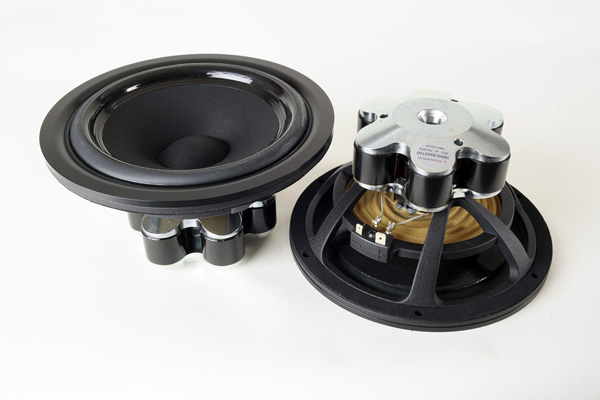
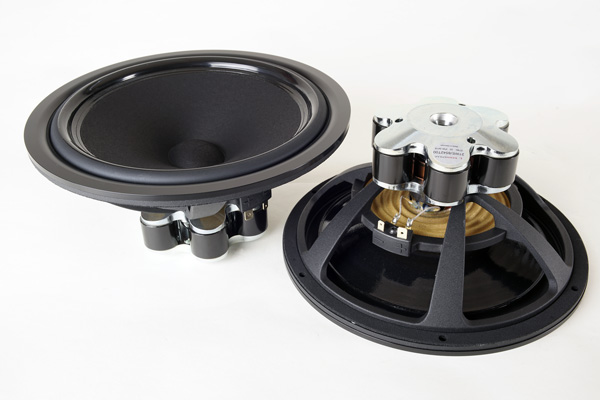
Click images to view large.
Here the 8 Ohm versions of 18WE and 21WE are used.
Download specs:
D3404/552000 21WE/8542-T00 18WE/8542-T00 32W/4878-T11
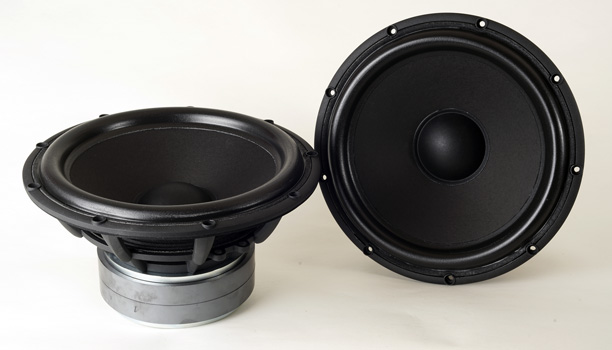
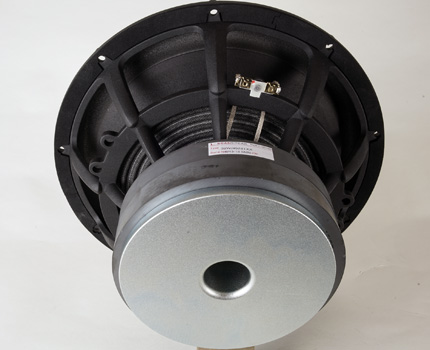
Prototype
32W/4878-T11 woofers. Brand-new woofers from SS. The final version will
have a rubber cover for the magnet. Not shown here.
Click images above to view large.
The final 32W/4878-T11.
The crossover, thanks to an inherent smooth response of the 18WE and
21WE drivers, features a simplistic approach with only a single coil to
the drivers, which produce 1st order roll-off of the drivers - and essentially
we have a 2½-way set-up. The tweeter section features a series resistor
and a coil. That's all.
Should you be fed up with capacitors and which one is best, you here
have the opportunity to evaluate your system without worrying about
any sonic degradation from crossover capacitors. Three coils, two
resistors, that's all.
Now, to pull off this unusual feature, we need a high-efficiency tweeter that needs
quite some attenuation as the series resistor (R1) combined with the coil (L1) goes
directly to ground. The minimum impedance reaches 2.9 Ohms and my EAR
961 tube power amp doesn't mind at all - and this even from the 8 Ohms
taps. For once the 4 Ohms taps goes well too, although at a slight decrease
in level.
R1 resistor directly connected to ground via L1 can draw some current,
hence here made up from 3 x 10 watt resistors as seen on lay-out. This
to have them stay cool. Initially I use 2 x 10 watts and they were never
more than lukewarm at very loud levels, but better stay on the safe
side.
The two
midrange drivers, having a combined membrane area of 366 cm^2 equal to a
large 10" driver, really don't do much to produce significant sound
levels. And the Ellipticor drivers have an unusual dynamic headroom and
can be run hard before breaking up.
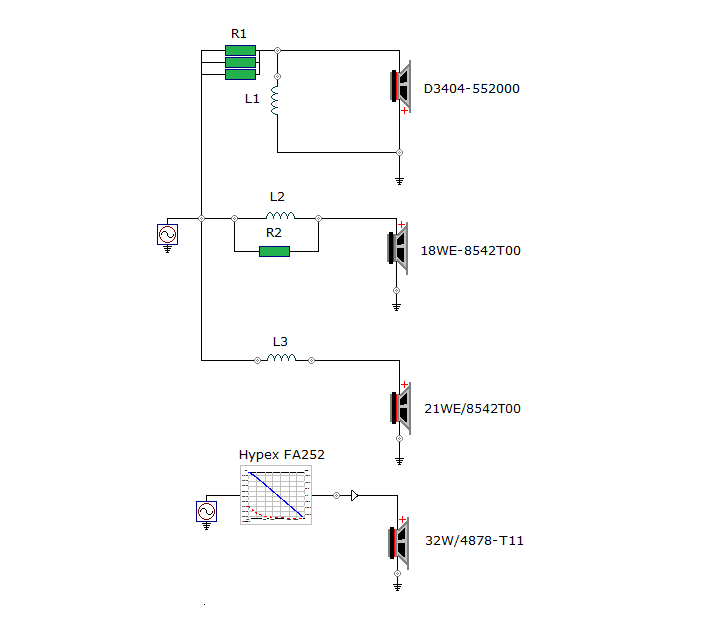
Now, this all looks very nice and simple but hardcore 1st order aficionados may object to the tweeter being connected with inverted polarity. What does the step response look like? We may produce a flat on-axis frequency response from drivers being out of phase but is this as good as can be? What does a square wave pulse look like? Etc., etc. 1st order filters are tricky and well-known examples can show elaborate crossovers that may shock people who think a 1st order filter is a just cap and a coil and nothing more.
There are very few true 1st order filter speakers in this world. Some
may claim they do 1. order filters, but it usually comes with a big grain of salt. The
filter may be 1st order on the electrical side, but even so, the roll-off can be 2nd, 3rd or
even 4th order from very simple filters - due to the drivers' inherent
roll-off. What matters is what happens on the acoustic side. And it all depends, because how far beyond the point of
crossover must a driver go 1. order before we can call it a true 1st order
filter? There are no rules for this, not even any general practice. Vandersteen is probably the company that does best in this area. My best
bid on this issue is 2 octaves above and below point of crossover. Based
on measurements in Stereophile, Vandersteen doesn't seem to always meet
that target.
Here
the 18WE driver follows 1st order roll-off up to around 6 kHz, then a
dip around 8-9 kHz and it stops around 15 kHz but never exceeds target
profile. The tweeter is pretty much 1st order all the way from 15 kHz down to 800
Hz, where is starts rolling off 2nd order. This is pretty darn good!

To produce a time-aligned, phase-correct system we could turn the
phase of the tweeter by adding an all-pass filter plus an impedance
flattening circuit as well, so the tweeter crossover all of a sudden
looks like above to the right. Quite elaborate compared to a single resistor and a
coil. Well, there's only one way to tell - to do it. Thus, the all-pass
filter was introduced and my trusted ears were invited again for an
audition: Blind test +/- all-pass section and impedance correcting
circuit. Frequency response <0.5 dB between crossovers. Some may argue
that even 0.5 dB difference between two identical crossovers/drivers are
audible, but this is the best we can do and the trained ear may be able
to focus on other things than amplitude.
So done, the all-pass version had thumbs down. This despite premium
components and careful fine-tuning. The simple "sine-cap" version had
better transparency and generally more life-like presentation. Another
thing is that when we use an all-pass filter we introduce a delay, thus
a negative response on the step response. We can't use all-pass filters
in a true 1. order crossover if we want the step response right.
Hypex FUSION plate-amp/DSP
Since launch the FA252 has been
replaced by FA501
Using the Hypex FUSION FA501 for high-level input operation
An easier way of powering the bass driver is by using the FA501, which takes a high level input, i.e. connect to speaker cables and adjust level with potentiometer on Hypex faceplate.
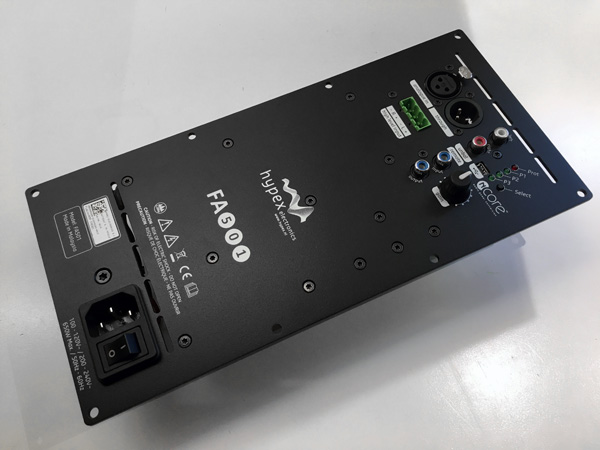
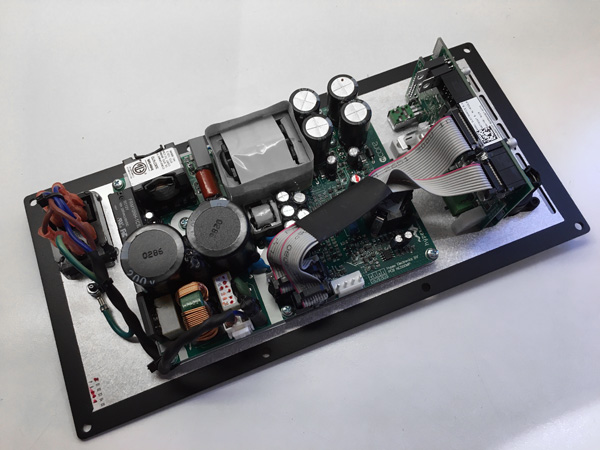
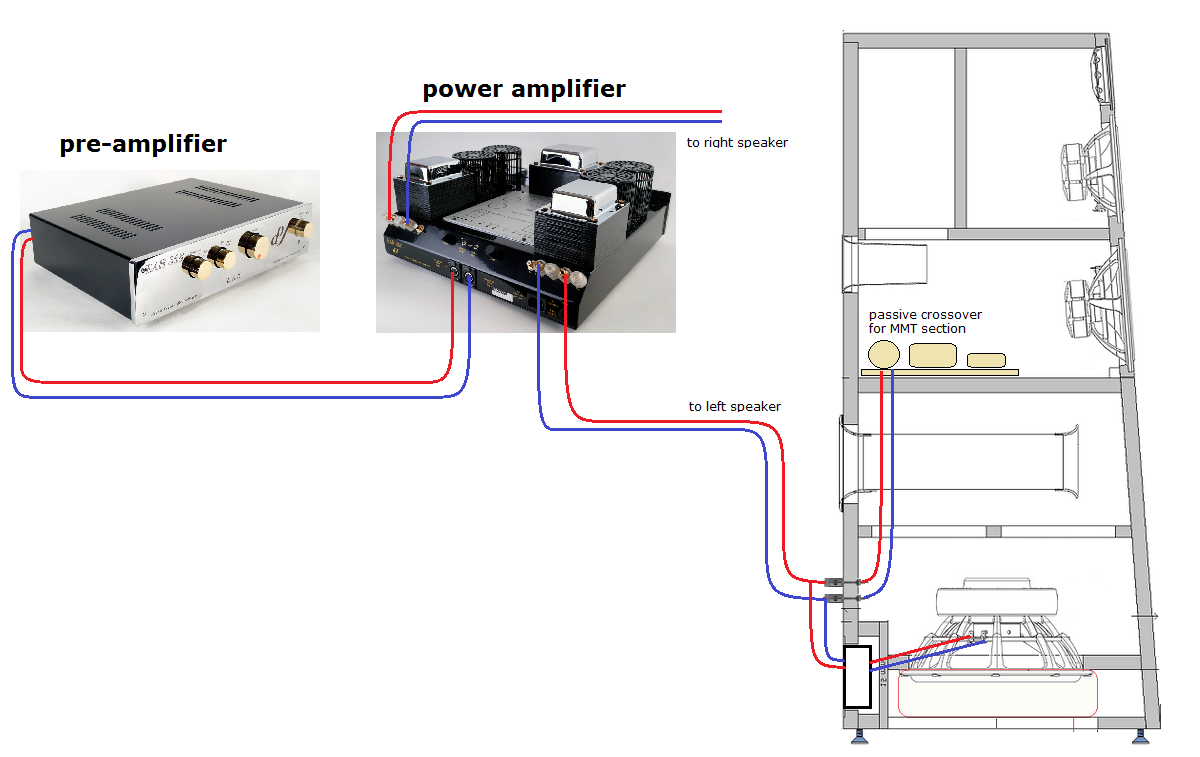
Here's the simple setup without the high-pass
filter before the power amplifier.
This give the full bass for 21WE and 18WE as these do not have a passive
high-pass filter.
This may work OK for most applications, but to get the full potential,
this is what is needed:
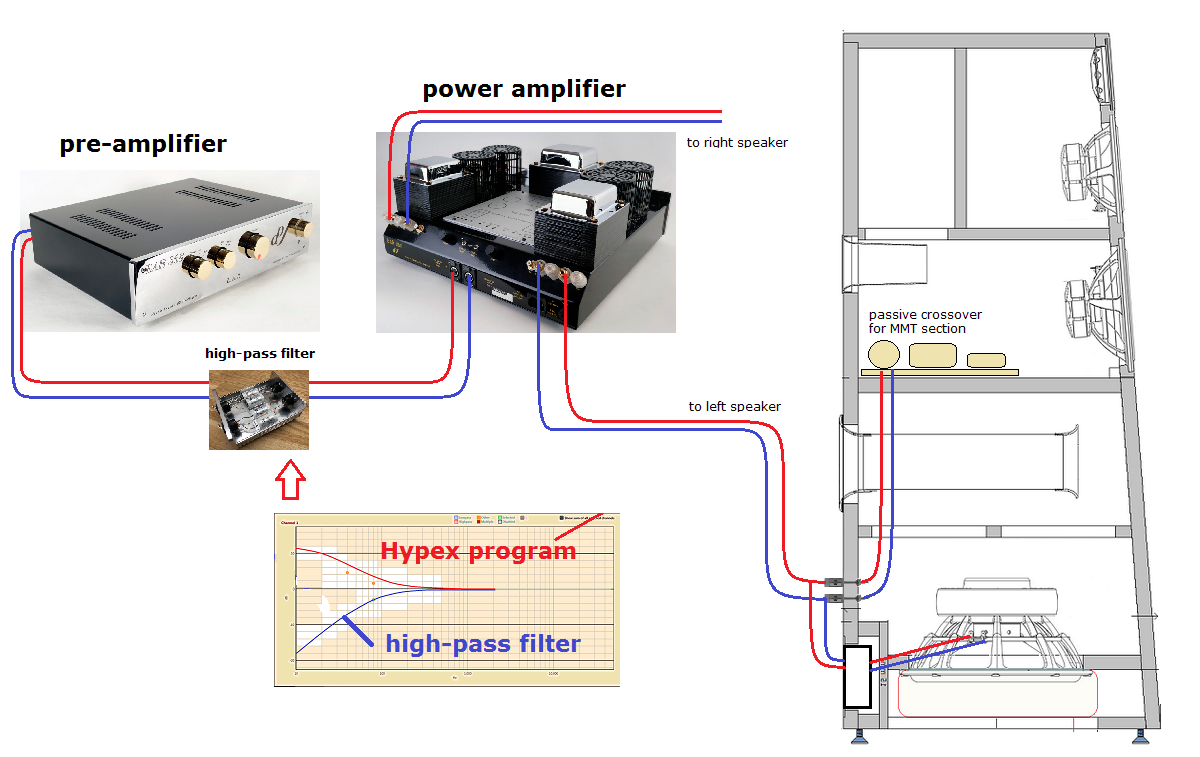
Here we have a
high-pass filter inserted before
the power amplifier, making a 1st order roll-off @ 100 Hz. Here you must
know the input impedance of your power amplifier, in my case with the
EAR-861, 10 kOhm, thus ~220 nF is needed for the high-pass filter. As I
run balanced operation I needed four 200 nF caps, here
Miflex capacitors. These caps obviously must be premium quality,
thus copper foil caps.
Now, what the Hypex now sees from taking a high-level input, is the blue
graph and this must be adjusted in the Hypex program to initially make a
flat response before we add our low-pass filter to the software.
Software for both options will be provided.
Download software
here for both scenarios.
- or from
here.
Scenario 1: No high-pass filter before power amp
Scenario 2: High-pass filter before power amp.
Do not use
Ellipticor-3_FA501_HP-power-amp file if you do not have the
the high-pass filter
-or you may damage the bass driver.
Open the zip file and extract the files to your FilterData folder in your MyDocuments folder.
Go to FA501 page for further instructions.
Strictly calculated the cabinets are 199 mm wide at top and 399 depth without
the front panel. I reality you aim at 200 mm width at top and 400 mm
depth. This makes the angle a tiny bit less than 5 deg. tilt of both
sides and front.
The material used here was 27 mm Baltic birch, which in fact was only 26
mm, just showing these things have tolerances. The panel between bass
and mid-bass drivers was 26 mm and for bracing and 18WE cabinet I used
20 mm BB. The rear panel of the Hypex compartment was 15 mm BB.
You can make it all from e.g. 22-25 mm MDF or similar. Do not use
standard plywood as this is much too light-weight and resonant for
speaker enclosures.
Faceting the top front panel was done on my table saw set to 30 deg.
angle. The table slider guide was set to around 2 deg., but must be tried out
to make it right. It can de done by hand like seen here:
http://www.troelsgravesen.dk/tips.htm#Faceting
Obviously you can make the front panel in one piece if preferred. I
needed flexibility for experimention, hence the upper part attached by
screws.
Do not change the front panel dimensions or drivers' placement or
you'll need a new crossover - and I can't help.
Workshop images
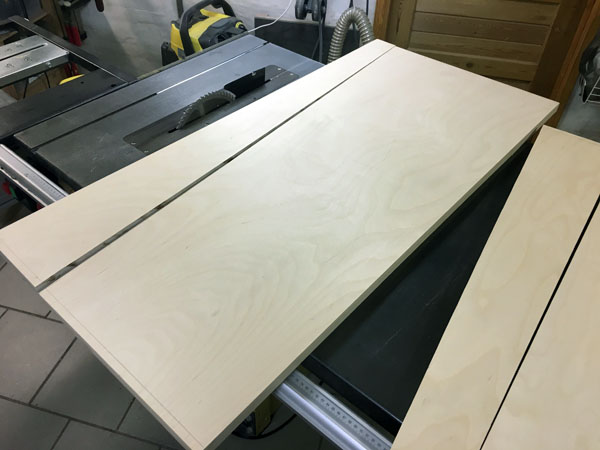
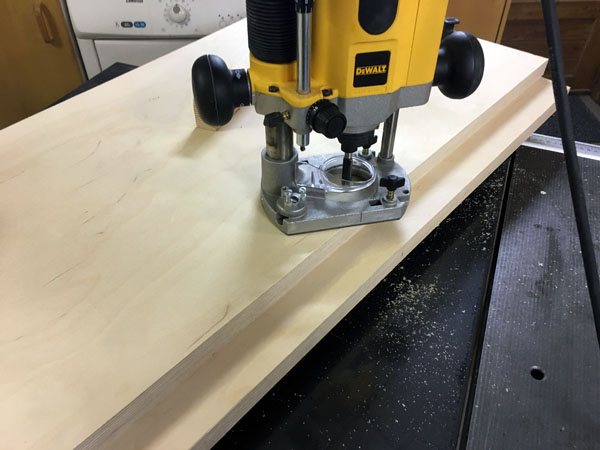
Side panel fronts were cut free hand and trimmed with the router.
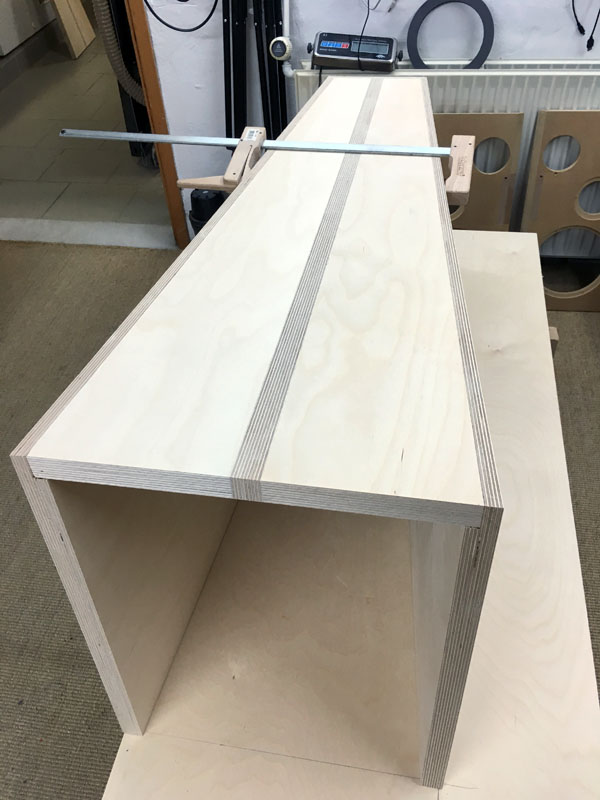
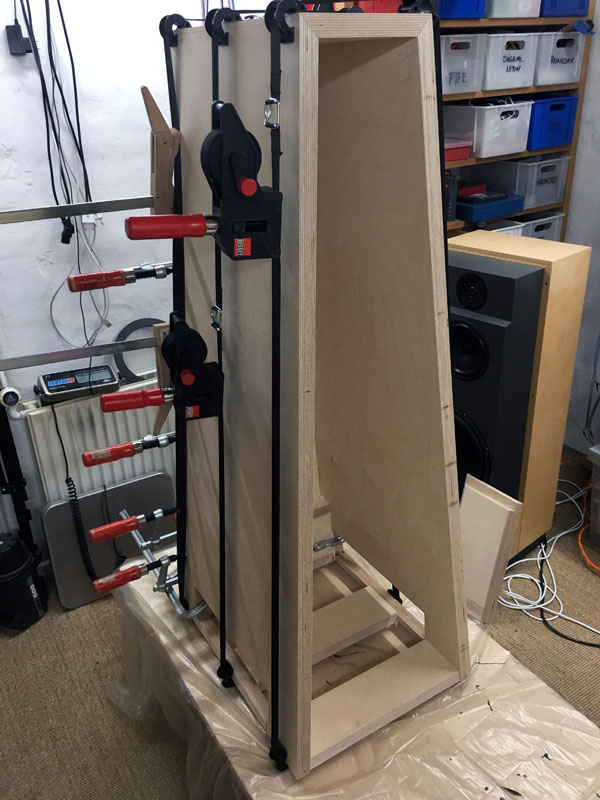
Cut-offs from side panels were glued with fillet to make rear panels.
Gluing sides, rear and top panels in one operation.
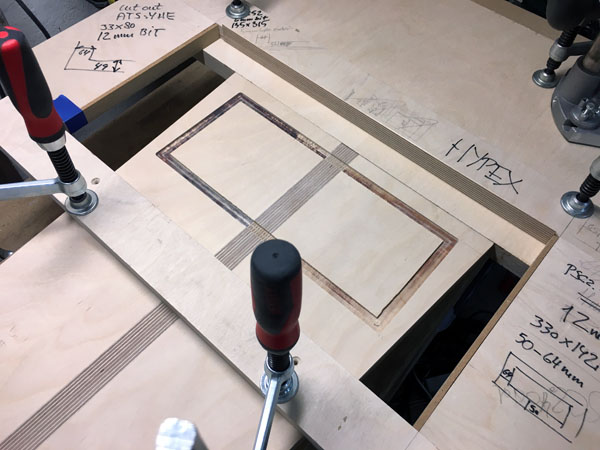
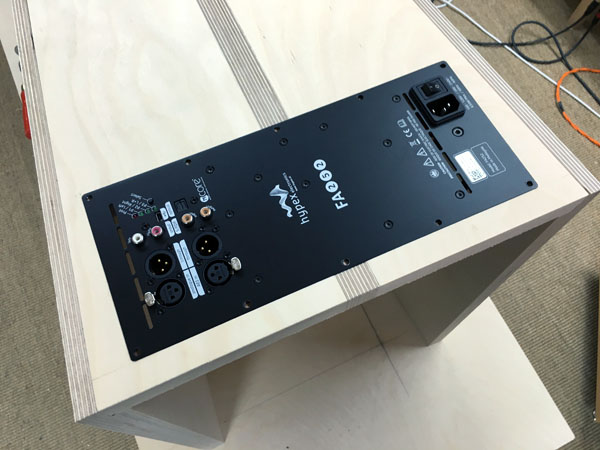
Routing for the Hypex module.
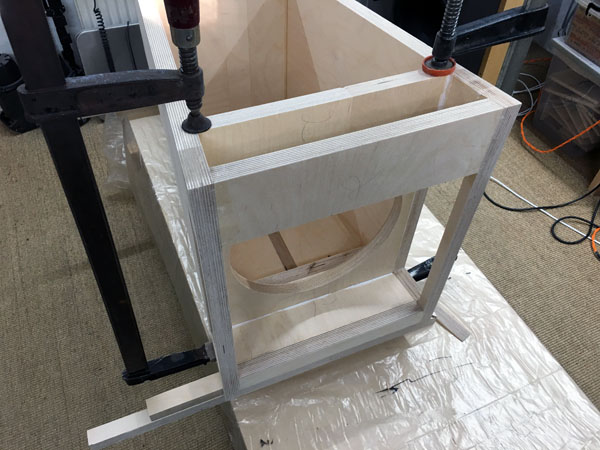
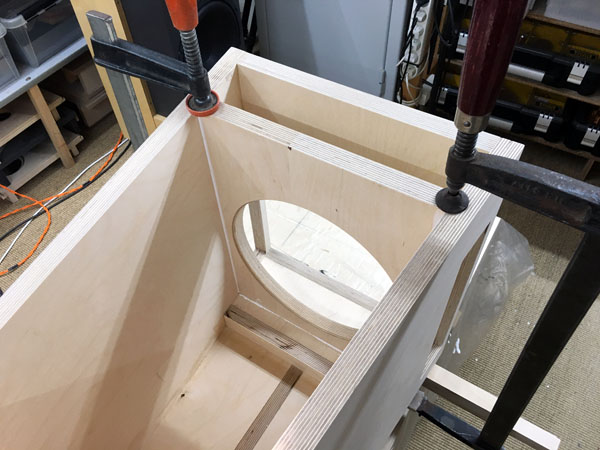
Mounting panel for bass driver.
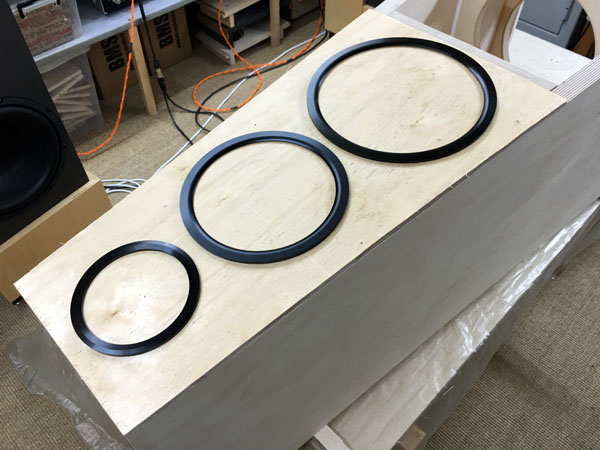
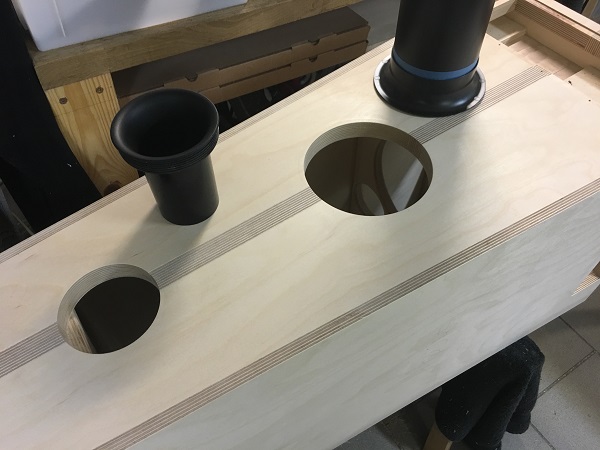
Preparing for driver front panel and routing
for ports. Holes are Ø96
and Ø149 mm.
The port for the 21WE is placed close to the bracing to allow space for
crossover on rear panel.
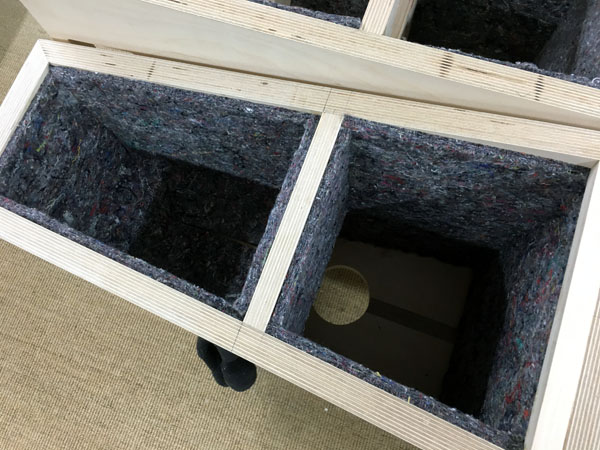
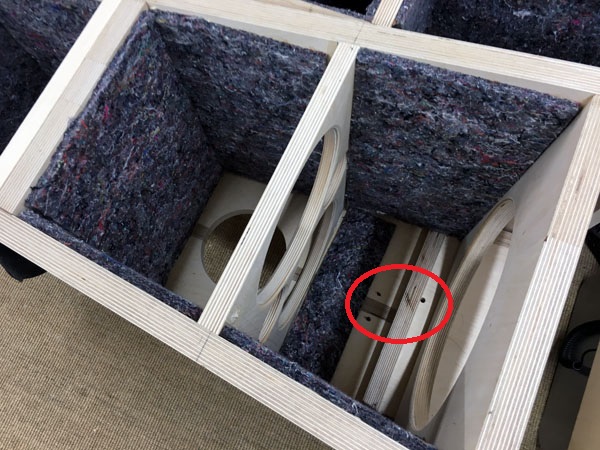
Lining internal panels with felt. Also felt on 32W front panel.
No felt on rear panel behind 21WE driver.
Make room for terminals and wire from Hypex module. Red circle.
The 18WE cavity is filled with 125 gram wool.
Drill holes for wires before adding felt. From terminals through 21WE
bottom panel and from 21WE cabinet to 18WE cavity.
Seal wires holes like seen
here. Make sure it's absolutely air tight.
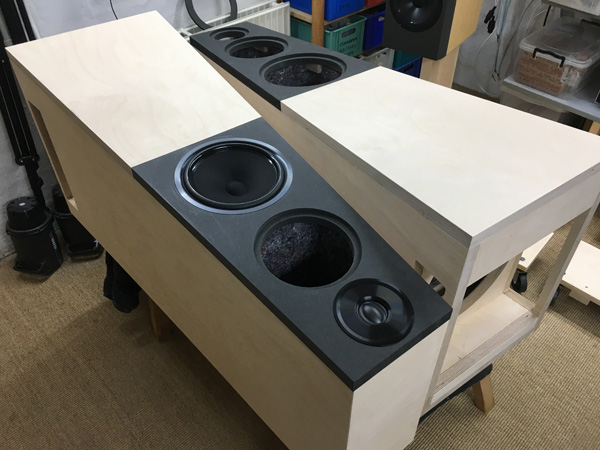
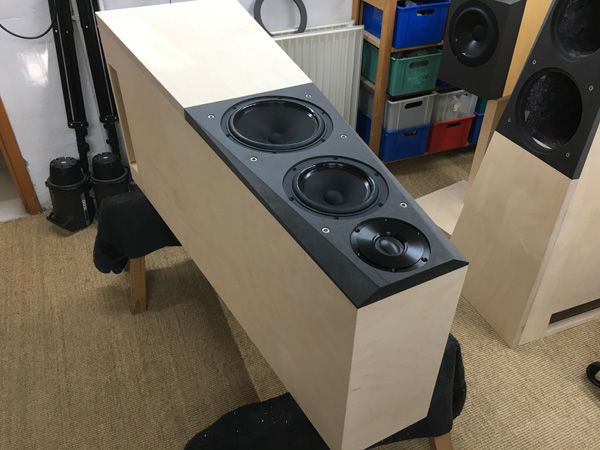
Making the front top panels, here attached by screws, as I may want to
try out other things. Normally I would use glue.
Faceting the top front panel was done on my table saw set to 30 deg.
angle. The table slider guide was set to around 2 deg., but must be tried out
to make it right. It can de done by hand like seen here:
http://www.troelsgravesen.dk/tips.htm#Faceting
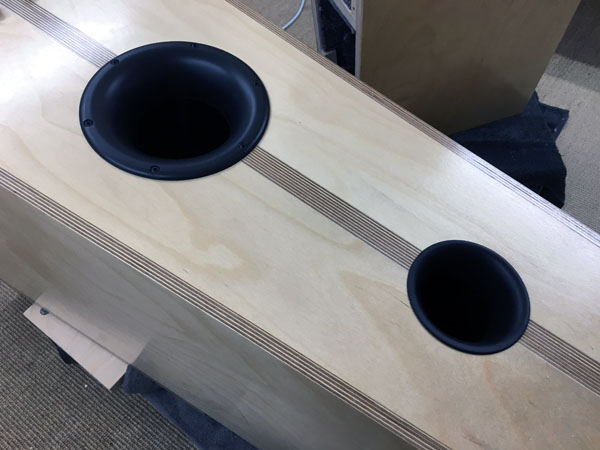
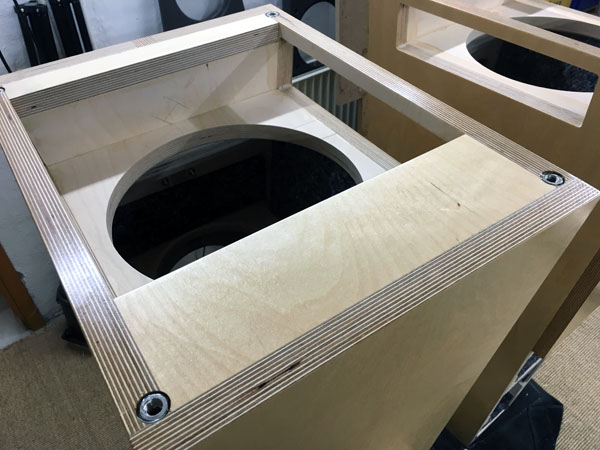
Ports in place and feet nuts fastened with araldite.
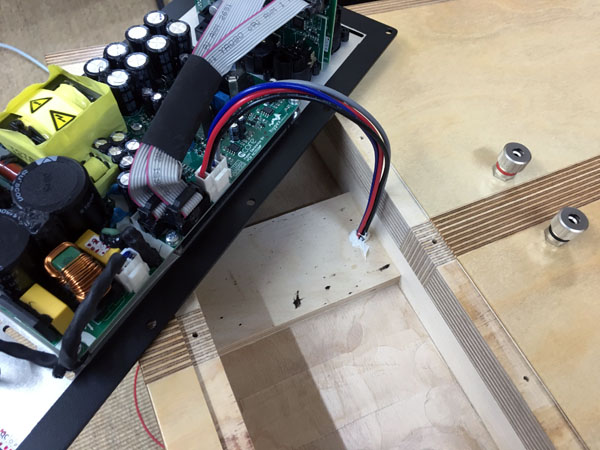
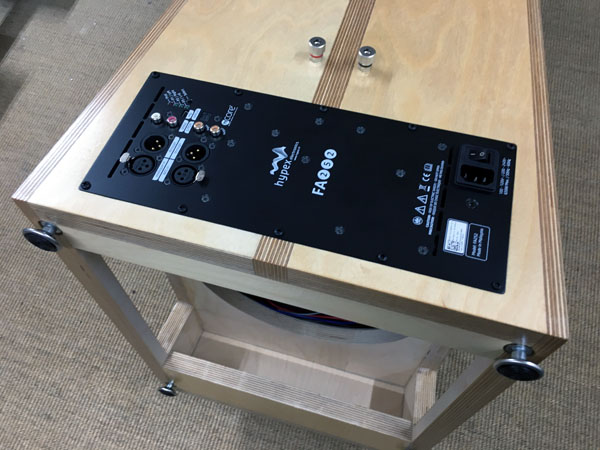
Hypex wires sealed from bass cabinet.
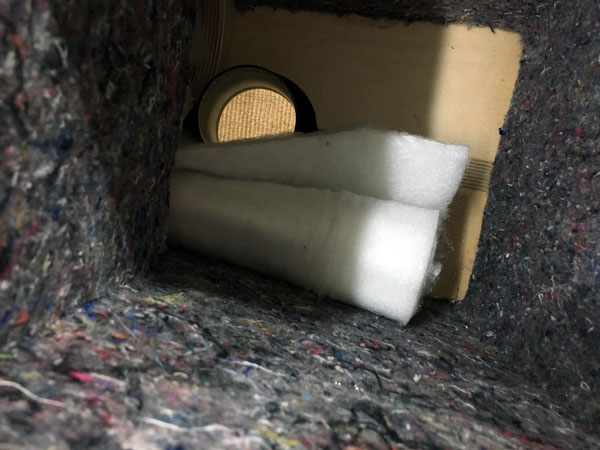
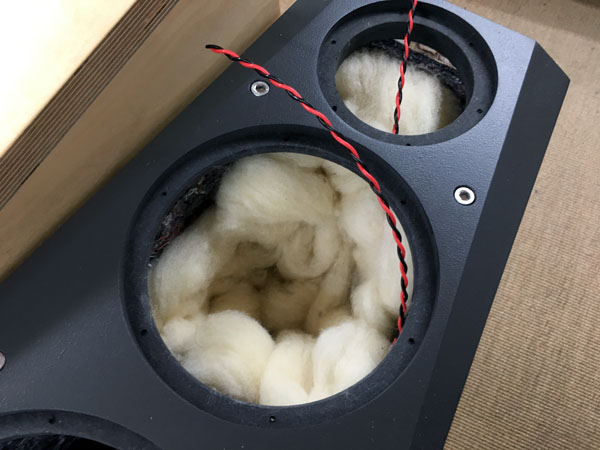
Cut two pieces of 30 x 50 cm acoustilux, roll and stuff the rear
compartment of the 21WE driver.
Weigh out 125 grams wool for 18WE compartment.
21W cabinet: Place a piece of 30 x 50 cm acoustilux op top of the
crossover on rear panel.
A piece of 50 x 35 cm acoustilux is placed at the bottom of the cabinet
and up on the sides as seen on image below.
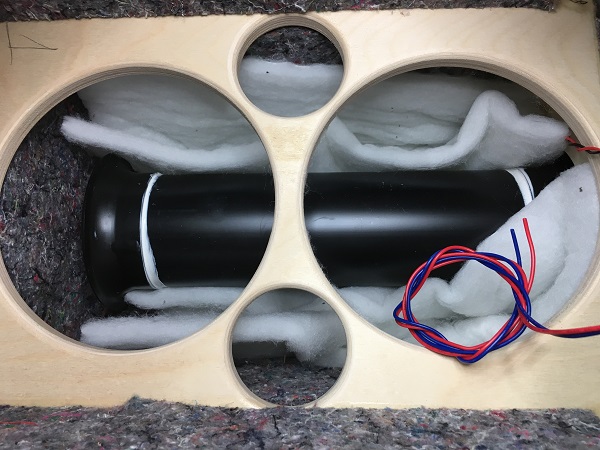
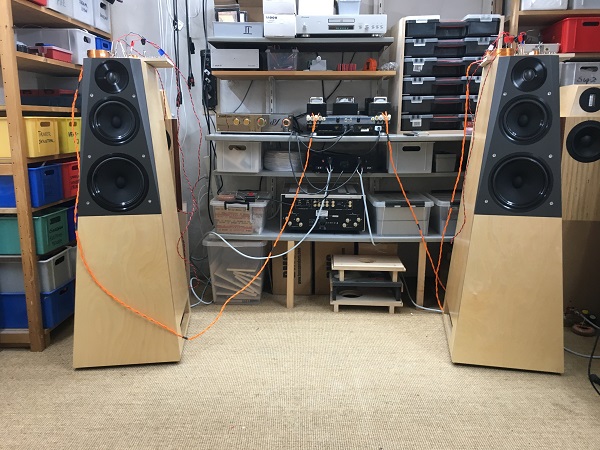
Left:
Place two pieces of 30 x 50 cm around the port at the top of the bass
cabinet. Right: First time set-up of speakers.
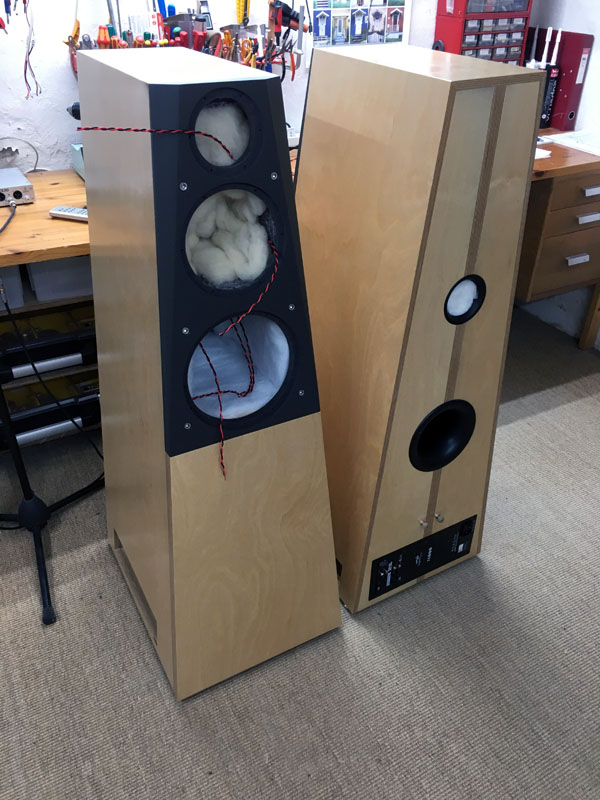
All wires ready for drivers.
Cut piece of 10 x 50 cm acoustilux, roll gently and stuff the 21WE port.
Aperiodic tuning.
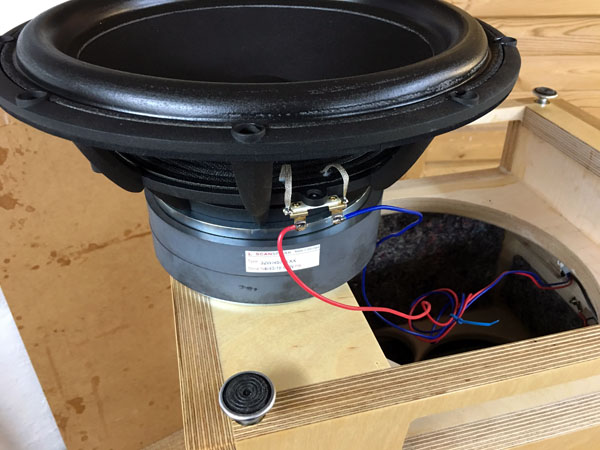
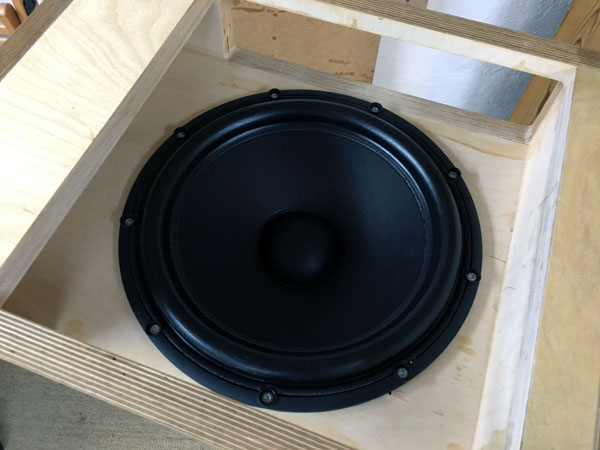
Installing the 32W bass drivers.
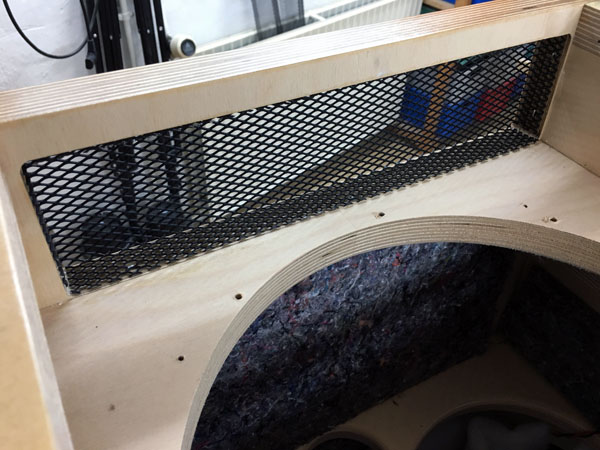
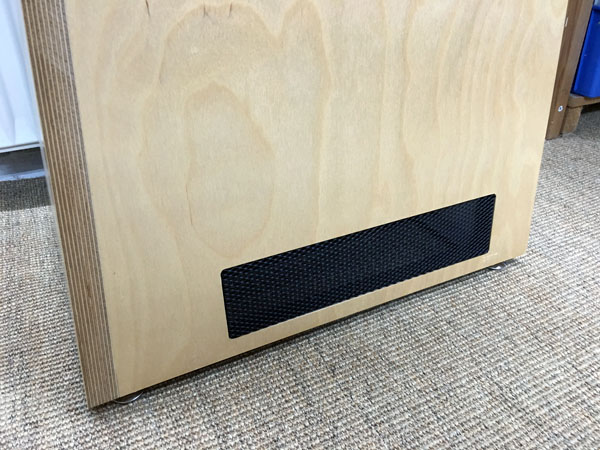
Making the alu grilles for the bass cab.
See ATS4-HE for details on the alu grilles:
http://www.troelsgravesen.dk/ATS4-HE.htm
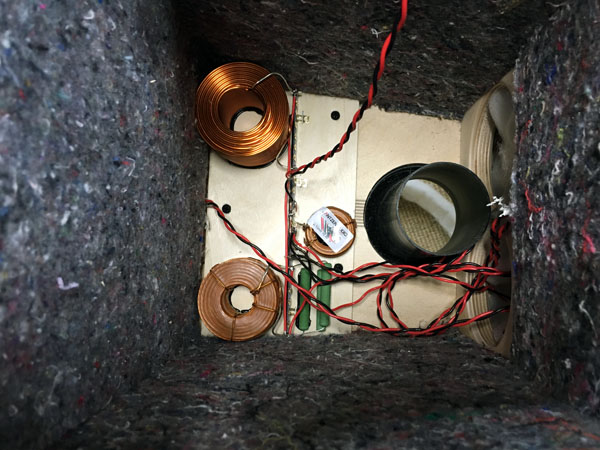
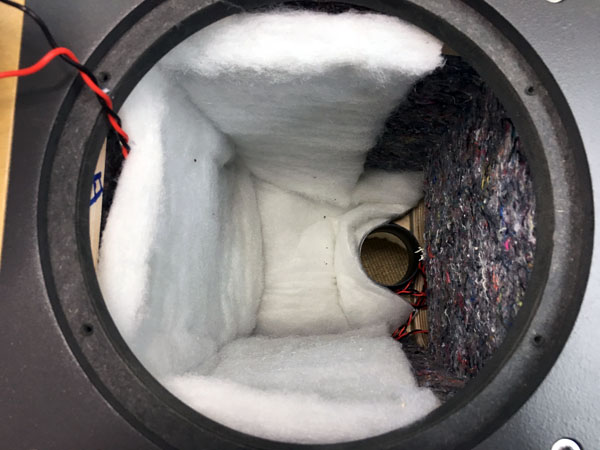
Mount crossover on rear panel below port.
Fold a piece of 25 x 50 cm acoustilux to cover the crossover.
30 x 50 cm acoustilux is placed at bottom and sides of 21WE cabinet - as
seen on image above.
Roll a piece of 10 x 50 cm acoustilux and stuff the port. Aperiodic
tuning.
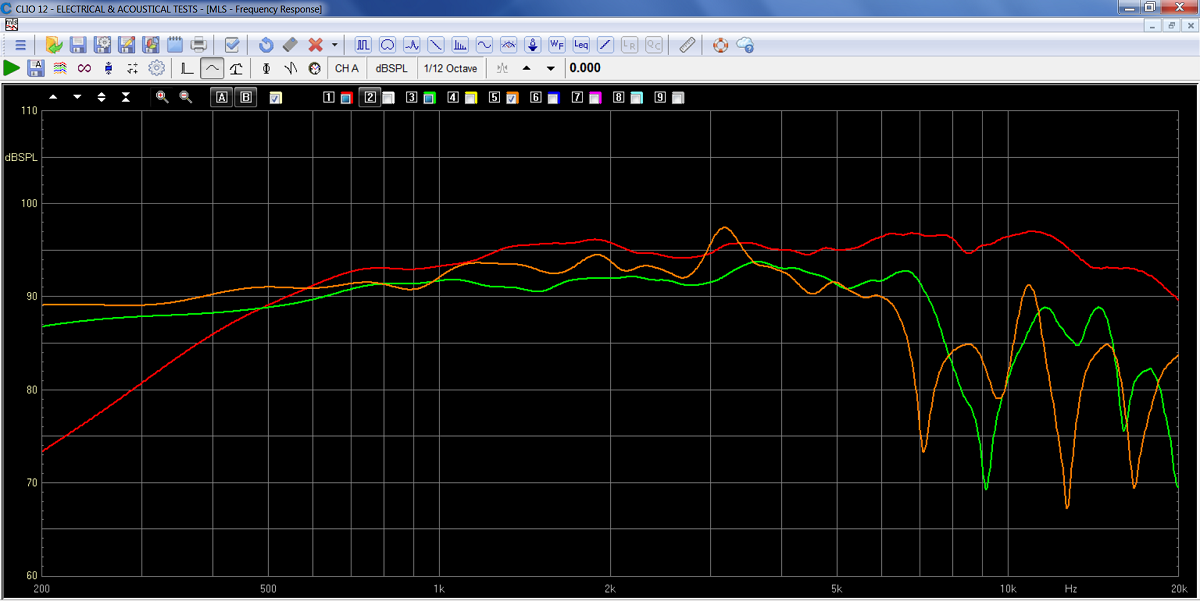
SPL of drivers on front panel. Green = 18WE, red = D3404 and orange =
21WE.
As can be seen the intrinsic response of the bass drivers are as flat as
can be for the 1st order crossover to these drivers.
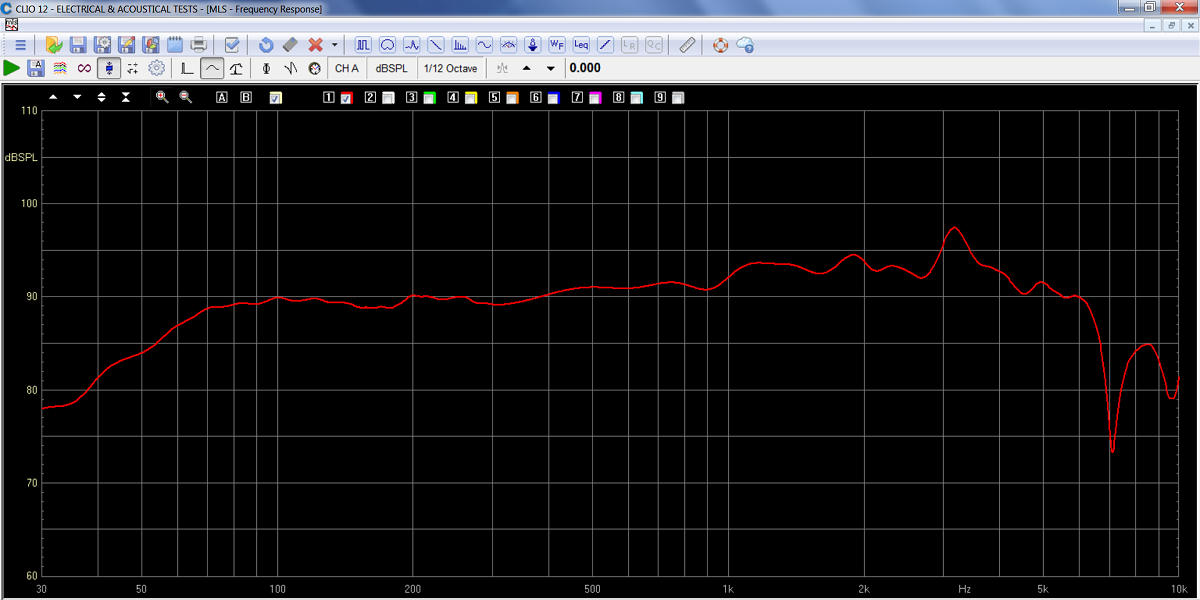
Let's have a look at the 21WE alone. Here merged with near-field
response @ 300 Hz.
This driver helps the 18WE maintain a solid response below 100 Hz, which
was the target: Having the 21WE + 18WE handle all of the middle-bass,
upper-bass and midrange.
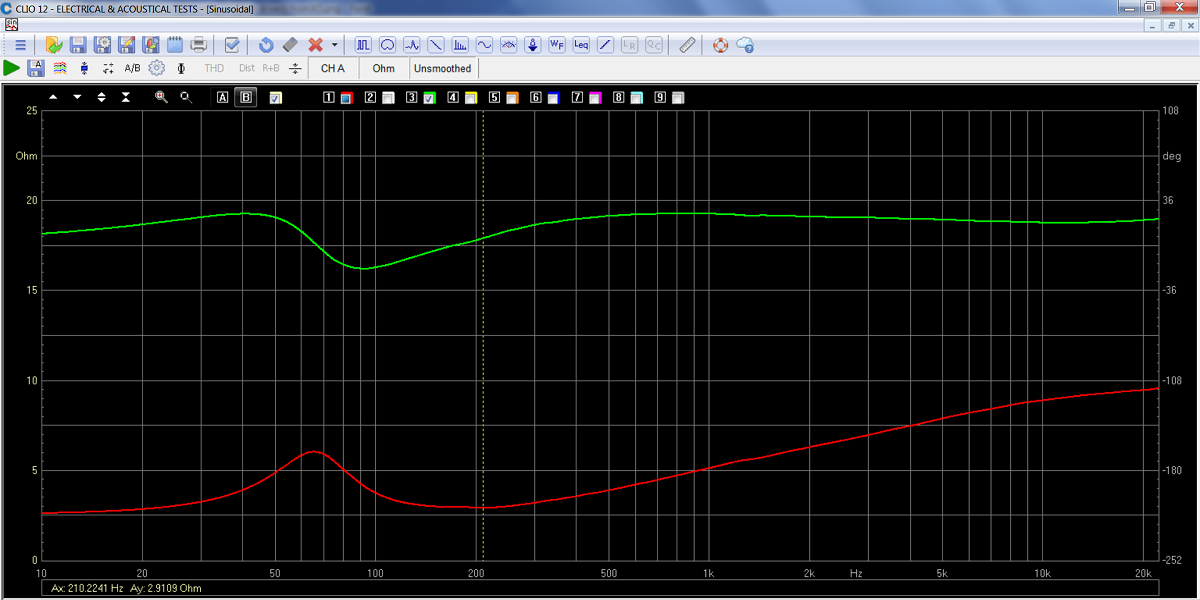
Red: Impedance of 21WE+ 18WE + D3404 driven from crossover. Green: Electrical
phase.
This proves an unusual flat profile, an easy load despite minimum
impedance of 2.9 Ohms.
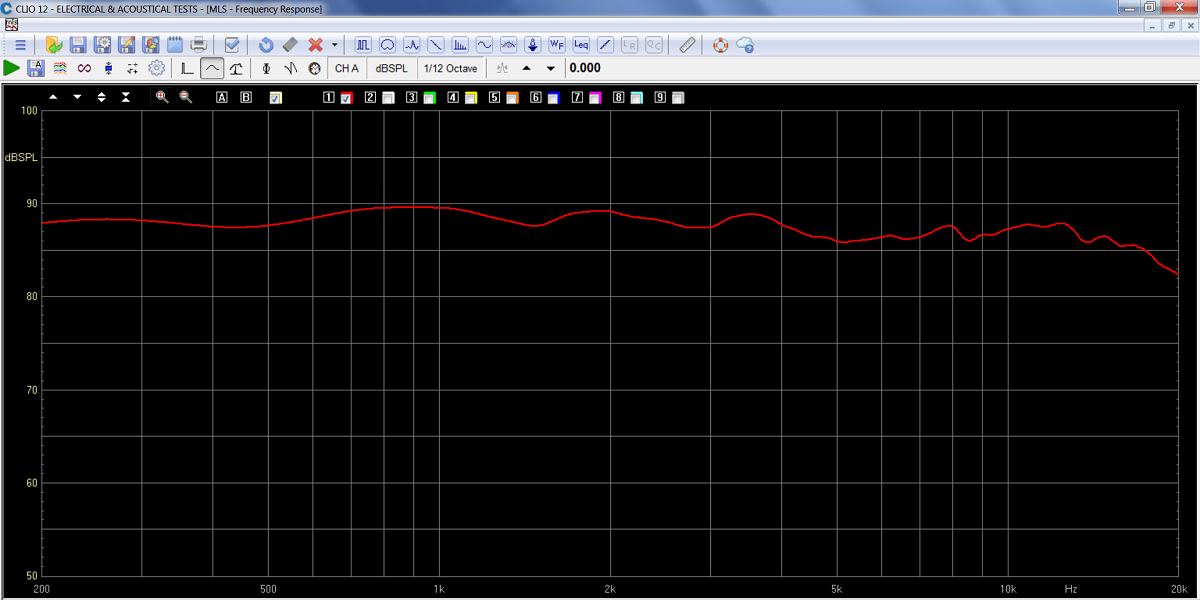
SPL of 18WE and D3404 driven from crossover.
The 21WE driver will lift the 200-500 Hz range up to around 91 dB,
which is the area that I would consider relevant to measuring overall
system sensitivity. Don't for a second think this speaker is treble shy,
despite the sloped response profile. It isn't.
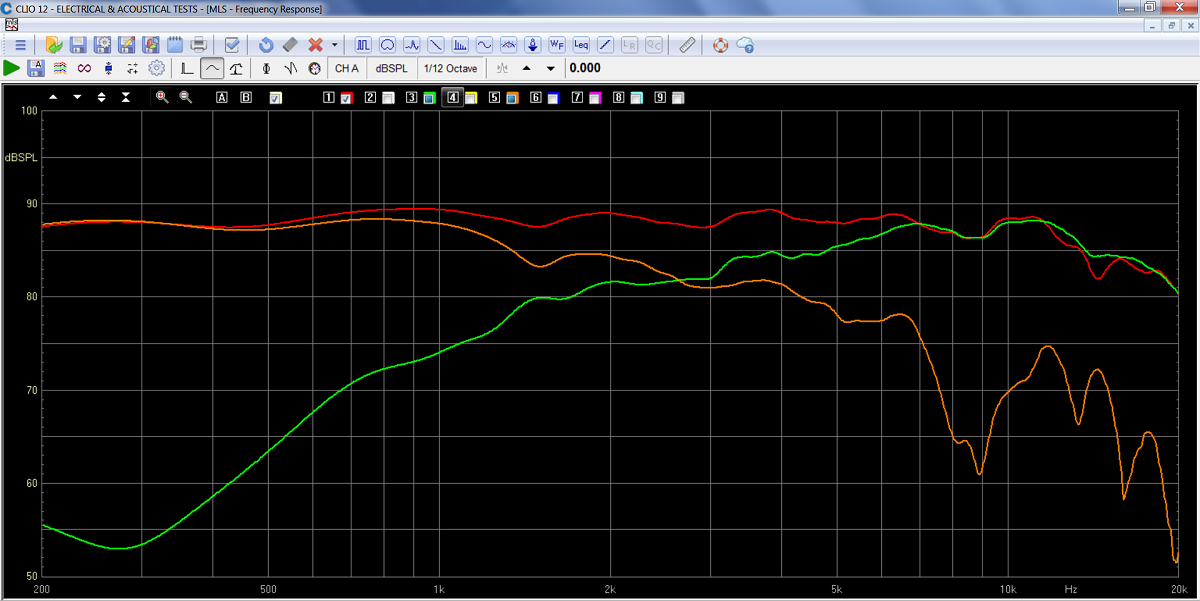
Above the response of 18WE and D3404 driven from crossover and summed
response (red).
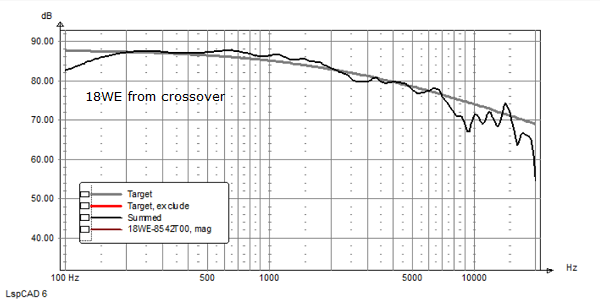
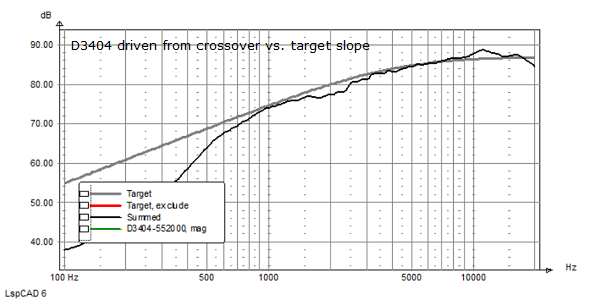
To the left the 18WE response vs. target profile. Right: Same for
tweeter.
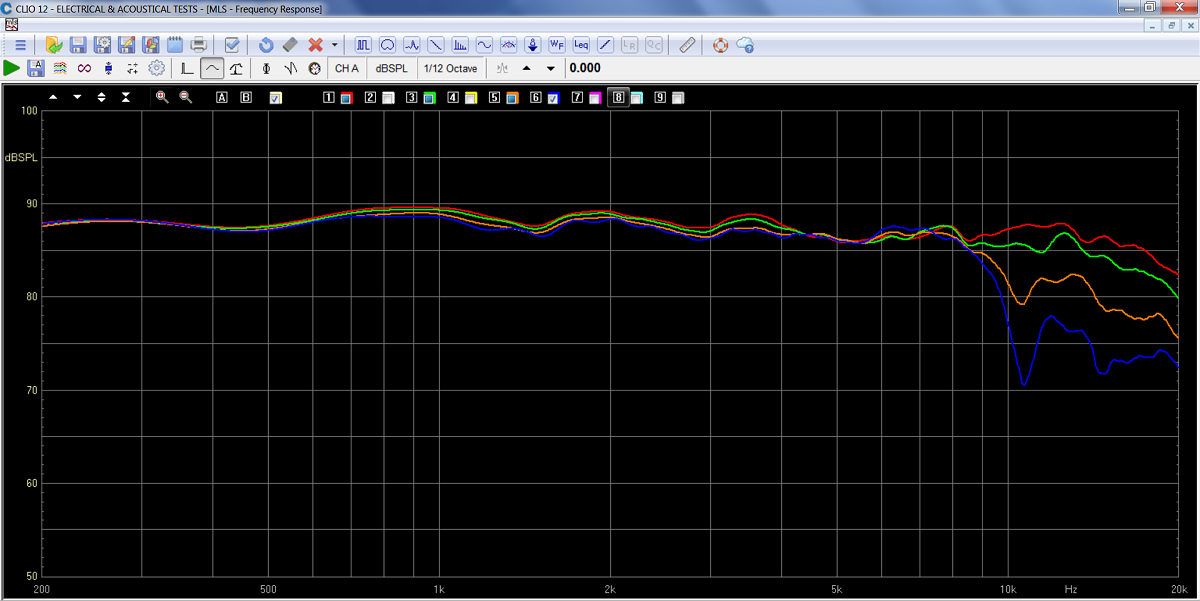
Horizontal dispersion @ 0, 10, 20 and 30 deg. off-axis. 21WE not
included in these measurements.
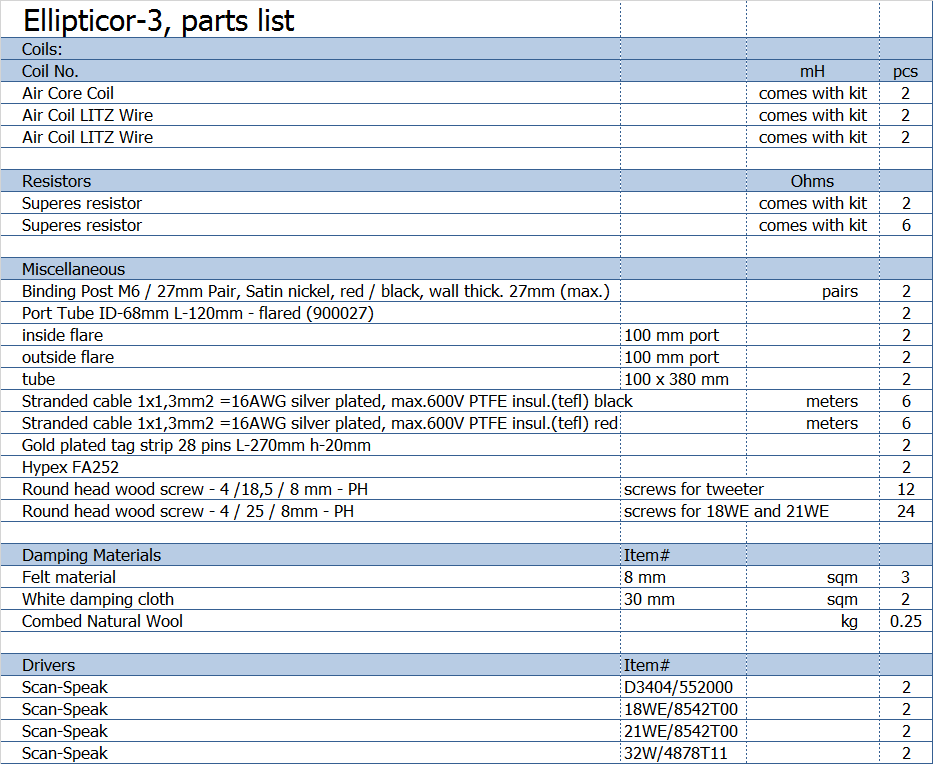
All kit and component prices may be subject to change and are always to be confirmed by Jantzen Audio Denmark.
Download Kit
Sale Presentations:

All technical questions to troels.gravesen@hotmail.com
All questions regarding purchase of kits, please mail Jantzen Audio at contact@jantzen-audio.com
CROSSOVER-LAYOUT
BACK TO INDEX
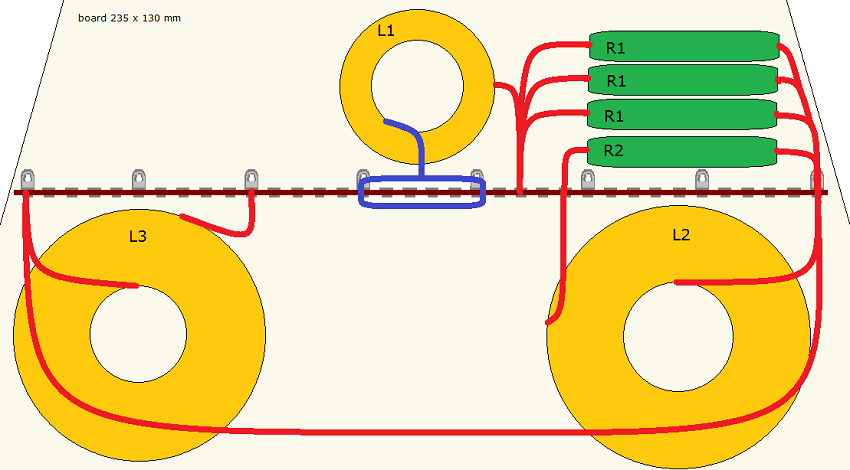
Board is 225 x 130 mm. Cut corners 5 deg. to half width.
Place crossover on rear panel below port in 21WE compartment.
Wiring

Pay notice to tweeter connected with inverted polarity.
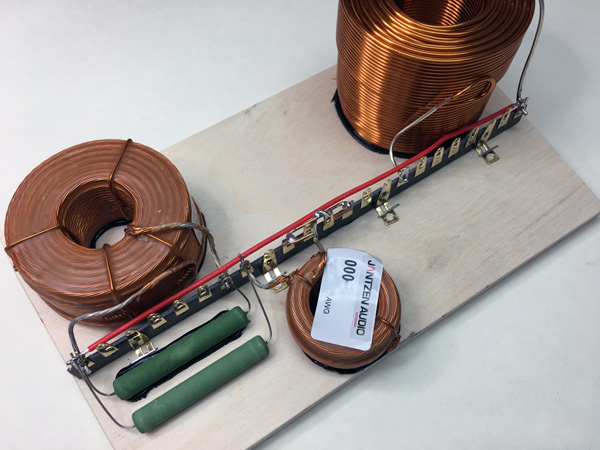
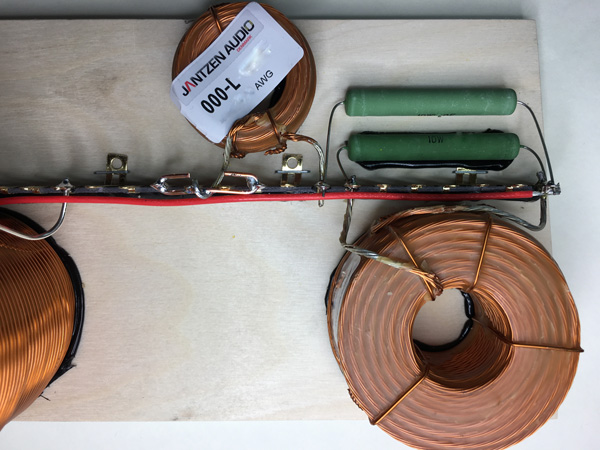
Click images to view large.
All R1 resistors not shown. See layout.
Bringing the Ellipticor-3 into our living room for the first time and
putting on the above 45 rpm vinyl (Vincent Belanger), something happened that rarely
happens. The dynamics, the see-through, the visceral presence of the
cello there in our living room. No speaker entering our living room has
ever had this coherent presentation from the lower register to the very
top. This kind put the whole thing into a dilemma, because it clearly
demonstrates how higher order filters add an edginess to every note
played and how transparency is reduced. But not all driver can handle 1st order filters and we
compromise. And the "compromise" can sound very well; very, very well
indeed, but not exactly the same way as drivers freed from time delay or
phase distortion. Only first order filter are free of time delays and phase
distortion.
Equally exciting was it to put on the re-mastered "White Album". Not all
mixed to my liking, but the level of detail is something if you were
young in the Sixties, where my first vinyl purchase was Sgt. Pepper, at
the horrific sum of 42.50 Danish Kroner, which is equivalent to around
53 EUR in today's money. New LPs were expensive!
We cannot tell what a speaker
sounds like, but clearly this is a large full-range system with a
significant capability in the lower registers. Next we notice
significant sensitivity. This speaker doesn't need a lot of power to run
the top system. My 32 wpc tube amp does very well and I never noticed
any sign of distortion playing seriously loud..
I recently went to a hifi show in Copenhagen, and no different from any
other show, a lot of pling-plong electronic music was played that
doesn't tell a thing about amps, speakers, cables, or anything else in
the chain. Electronic music can sound like anything and we have no
reference for what it should be like. Acoustic music recorded in real
world rooms with not too much artificial processing is what counts when
it comes to evaluating systems and admittedly there were a few playing
decent acoustic music.
Response from visitors were unanimously this: "Natural". Rather than creating
a bubble of sound around the speaker, it's "see through", or rather
"hear through". Depth and three-dimensionality are the key words in
describing the sound of this loudspeaker. Conventional crossovers may be
smooth and easy on the ear, but compared to 1st order filters, they
always have an edginess in their transient response, which may be
perceived as positive - to a certain degree - but is mostly related to
the rapid phase shift generated by the crossover - and driver. So, why aren't all my
crossovers 1st order? Simply because most drivers do not allow 1st order
filters due to irregular frequency response and it would take all kinds of
correction circuits to reach target roll-off. All speakers are
compromises.
More often than usual I have gone to the speakers to see if I had the
speaker wires connected correctly. On very good recordings you come
aware of phase issues and mixing with regard to placement of microphones
in the studio/hall where the recording was made. You clearly hear what
instruments are mixed in pure mono, being in one channel or spread
across channels.
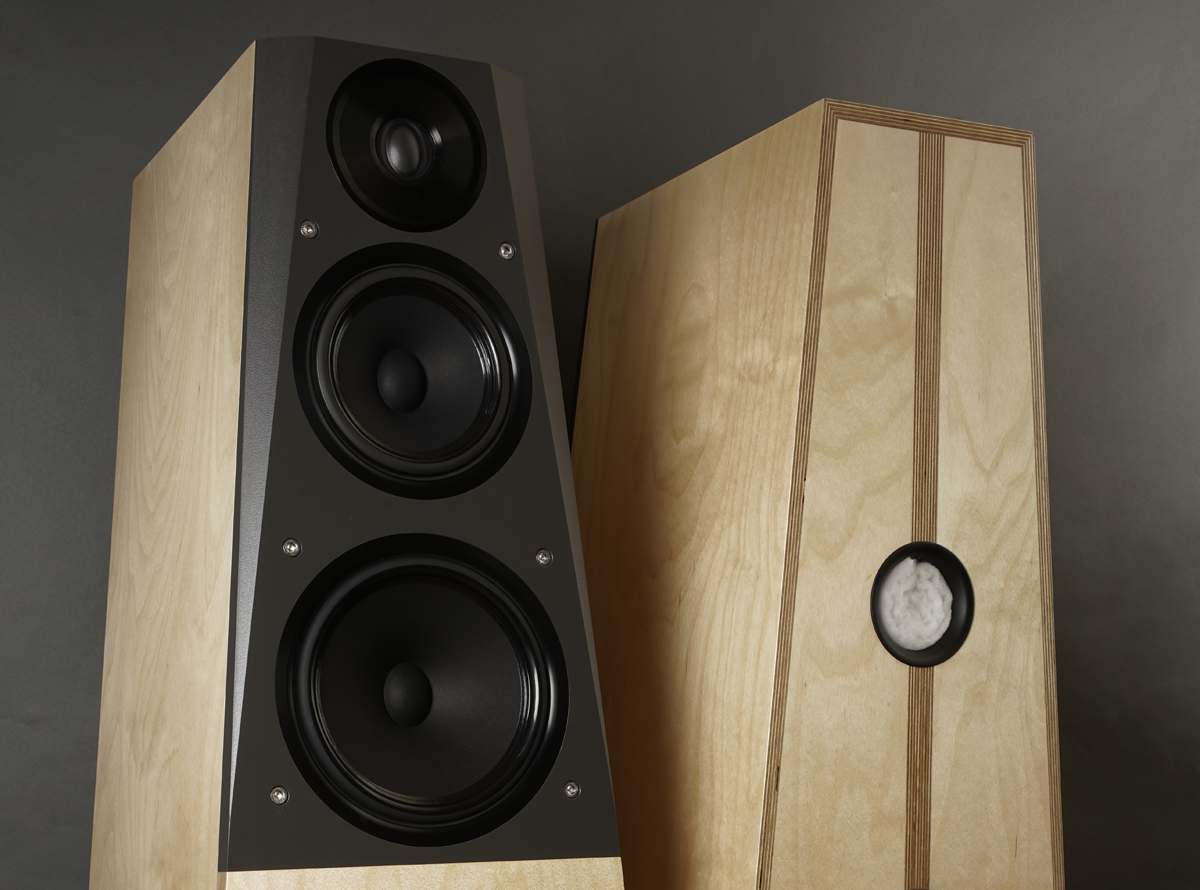
If you don't like the front panel screws, it looks like this, thanks to photoshop:
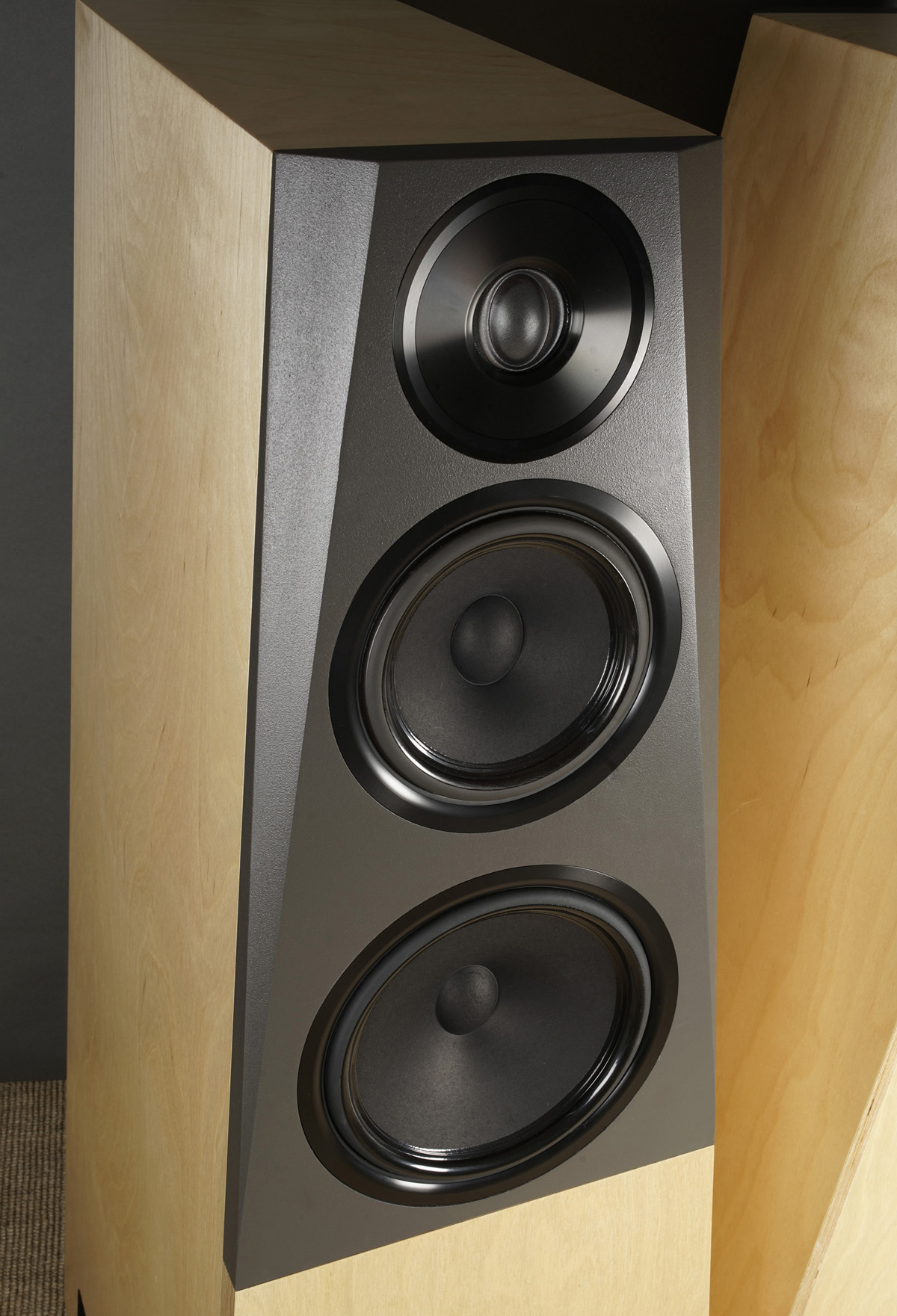
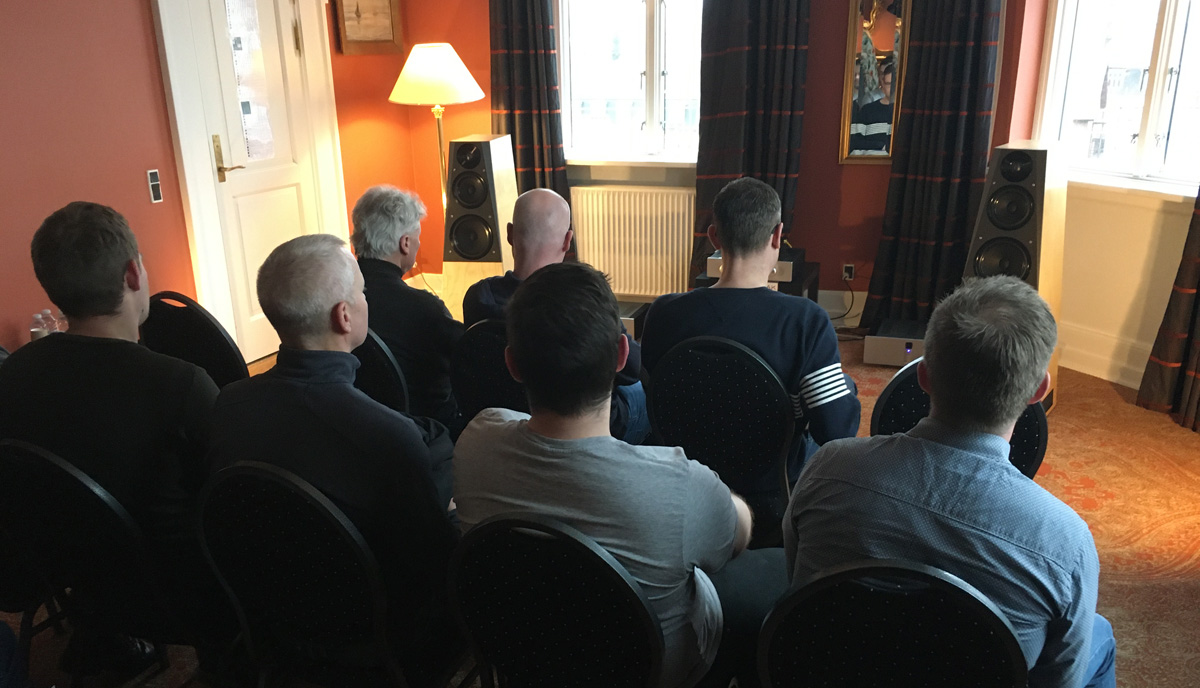
Ellipticor-3 at a local hifi show, 2020.
Driven by double Gamut amplifiers and with my high-pass filter in front
of the amp running the MMT section.
